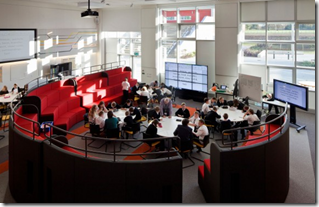Rethinking learning environments
Today, I accompanied a group of teachers around the Microsoft office here in Sydney to show them what a modern enterprise office environment feels like. Shared, common work spaces, numerous different types of meeting rooms and areas; lounge areas, board rooms, break out areas, flexible meeting areas and casual furniture to encourage discussion and team work, are all supported with technology that enables us to work more effectively than sitting together in our own siloed cubicles from 9 until 5. Why should this be any different in school environments?
Classrooms were developed to produce members of the industrial revolution workforce. What are classrooms today producing? A slightly broader range of graduates than 150 years ago I would propose. Students today will be entering environments like our office in Sydney where there is an emphasis on sharing and learning from one another. If I want to sit beside legal (not likely!) then I can, nothing stopping me.
Normal practice and design is to silo children into 7x7 classroom where they all sit facing the front and waiting for information to be delivered to them. We all know that this is not how we want children to be taught. In fairness, so many innovative schools and teachers have torn up the old rule book and have created real dynamic, engaging classroom environments where children and students are encourages to work together and develop their skills in a manner that suits them. We probably all know of, or are indeed are a, teacher who is using flexible or agile learning spaces to really make 21st century skill development happen and come alive for their students. But how can we change a normal classroom into a space that is more engaging and empowering for the tenants of these spaces. I think if 21st century skills are to be taught most effectively, the environment in which they are taught needs to be revolutionised.
Some simple concepts and useful resources that I've come across lately around learning spaces are:
Campfire setup
The picture I've included, is certainly at the top end of the scale of campfire type classroom setup but don't be deterred by this. This setup can be easily achieved in any classroom. What it achieves is creating a more democratic feeling, engaging environment where all kids have equal access to the teacher, as he or she is presenting and teaching in the middle of them, and they all have equal access to each other for discussions and student led lessons.
While in the INSPRIE Centre in the University of Canberra recently, this concept is probably one of the simplest yet most useful elements of a learning environment I've seen. The enthusiasm that workshop participant took to using the walls to write on for brainstorming and concept presentation was inspiring, excuse the pun. It's a simple concept but one that adds an element of fun to the at times difficult task of getting a number of people really collaborating in the classroom.
Flexible Furniture
As daily lessons and tasks change the size and members of class groups, the class environment will need to change to suit these needs. All kinds of agile class furniture can be purchased to make this flexibility easy.
The Language of School Design - Book summary.
There is a mass of great ideas in this book on a broad range of topics such as furniture, natural ventilation, connecting to the community, and home base and individual storage, to name a few. For anyone with a keen interest in school design, this is a fantastic resource and I would encourage you to purchase the complete book, now in a second revised edition.
This is an issue that everyone is talking about now. There is no doubt that we need to move away from the lecture style structure of the past 150 years and develop learning environments that really encourage and enhance 21st century learning. To see how successful one school has been since developing these spaces throughout their school, watch the following video. I didn’t want to get into too much building and technology detail today, I just wanted to put some simple ideas out there to help enhance the classroom experience for your students. Why not change the layout of your room or get some mobile whiteboards to collaborate on, better paint a wall with IdeasPaint and see how the dynamic changes in your classroom.
I'd love to get a collection of Australian innovative learning spaces so feel free to post links to pictures, videos and articles about local spaces that are really enhancing children's learning experiences.
New Line Academy - Learning Enviornments




